The birth of the Soviet missile defense system. Transistor machines of the USSR
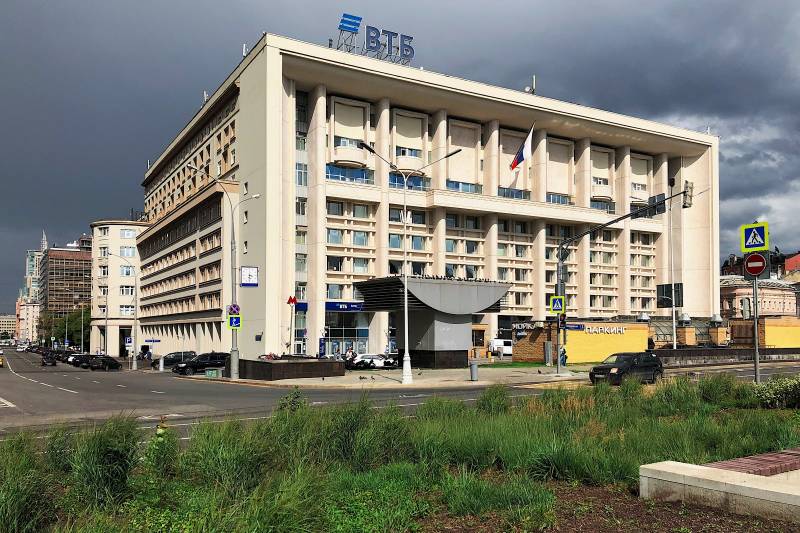
Turgenevskaya Square, VTB Bank office - the former building of the USSR Ministry of Radio Engineering and Electronic Industry - built in 1982. Source: moskva.pictures
Hearing aids
Recall that Bell Type A were so unreliable that their main customer, the Pentagon, revoked the contract for their use in military equipment. Soviet leaders, already then accustomed to orienting themselves toward the West, made a fatal mistake, deciding that the very direction of transistor technology was futile. We had only one difference with the Americans - the lack of interest on the part of the military in the United States meant only the loss of one (albeit rich) customer, while in the USSR a bureaucratic verdict could condemn an entire industry.
There is a widespread myth that precisely because of the unreliability of Type A, the military not only abandoned it, but also gave it to disabled people for hearing aids and allowed, in general, to declassify this topic, considering it unpromising. This is partly due to the desire to justify a similar approach to the transistor on the part of Soviet officials.
In fact, everything was a little different.
Bell Labs understood that the significance of this discovery is enormous, and did everything in its power to ensure that the transistor was not accidentally classified. Before the first press conference on June 30, 1948, the prototype had to be shown to the military. It was hoped that they would not classify it, but just in case, lecturer Ralph Bown took it easy and said that "it is expected that the transistor will be used mainly in hearing aids for the deaf." As a result, the press conference passed without hindrance, and after a note about it was placed in the New York Times, it was too late to secret something.
In our country, the Soviet party bureaucrats understood the part about "apparatus for the deaf" literally, and when they learned that the Pentagon did not show interest in the development so much that it did not even have to be stolen, an open article was published in the newspaper, without realizing the context, they decided that the transistor useless.
Here are the memoirs of one of the developers Ya.A. Fedotov:
“The transistor will never fit into serious hardware. The main promising area of their application is hearing aids. How many transistors are required for this? Thirty-five thousand a year. Let the Ministry of Social Affairs do this. This decision slowed down the development of the semiconductor industry in the USSR for 2–3 years.
This attitude was terrible not only because it slowed down the development of semiconductors.
Yes, the first transistors were nightmares, but in the West they understood (at least those who created them!) That this is an order of magnitude more useful device than just replacing a lamp in a radio. The Bell Labs employees were real visionaries in this regard, they wanted to use transistors in computing, and they applied them, even though it was a poor Type A, which had a lot of flaws.
American projects of new computers started literally a year after the start of mass production of the very first versions of the transistor. AT&T has held a series of press conferences for scientists, engineers, corporations and, yes, the military, and has published many key aspects of the technology without becoming patentable. As a result, by 1951 Texas Instruments, IBM, Hewlett-Packard and Motorola were producing transistors for commercial applications. In Europe, they were also ready for them. So, Philips made a transistor at all, using only information from American newspapers.
The first Soviet transistors were just as completely unsuitable for logic circuits, like Type A, but no one was going to use them in this capacity, and this was the saddest thing. As a result, the initiative in development was again given to the Yankees.
USA
In 1951, Shockley, already known to us, reports on his success in creating a radically new, many times more technological, powerful and stable transistor - the classic bipolar one. Such transistors (unlike point ones, all of them are usually called planar in a bunch) could be obtained in several possible ways; historically, the method of growing a pn junction was the first serial method (Texas Instruments, Gordon Kidd Teal, 1954, silicon). Due to the larger junction area, such transistors had worse frequency properties than point ones, but they could pass many times higher currents, were less noisy, and most importantly, their parameters were so stable that for the first time it became possible to indicate them in reference books on radio equipment. Seeing such a thing, in the fall of 1951, the Pentagon changed its mind about the purchase.
Because of its technical complexity, 1950s silicon technology lagged behind germanium, but Texas Instruments had the genius of Gordon Thiel to solve these problems. And the next three years, when TI was the only manufacturer of silicon transistors in the world, made the company rich and made it the largest supplier of semiconductors. General Electric released an alternative version, fusion transistors, in 1952. Finally, in 1955, the most progressive version appeared (first in Germany) - a mesa transistor (or diffusion-alloyed). In the same year, Western Electric began to produce them, but all the first transistors did not go to the open market, but to the military and to the needs of the company itself.
Europe
In Europe, Philips began to produce germanium transistors according to this scheme, and Siemens - silicon. Finally, in 1956, the so-called wet oxidation was introduced at Shockley Semiconductor Laboratory, after which eight co-authors of the technical process quarreled with Shockley and, finding an investor, founded the powerful company Fairchild Semiconductor, which released in 1958 the famous 2N696 - the first silicon bipolar wet diffusion transistor oxidation, widely commercially available in the US market. Its creator was the legendary Gordon Earle Moore, the future author of Moore's Law and the founder of Intel. So Fairchild, bypassing TI, became the absolute leader in the industry and held the lead until the end of the 60s.
Shockley's discovery not only made the Yankees rich, but also unwittingly saved the domestic transistor program - after 1952, the USSR became convinced that the transistor was a much more useful and versatile device than was commonly believed, and threw all their efforts into repeating this technology.
the USSR
The development of the first Soviet germanium junction transistors began a year after General Electric - in 1953, the KSV-1 and KSV-2 went into mass production in 1955 (later, as usual, everything was renamed many times, and they received the P1 indices). Their significant drawbacks included low temperature stability, as well as a large scatter of parameters, this was due to the peculiarities of the Soviet-style release.
E. A. Katkov and G. S. Kromin in the book "Fundamentals of radar technology. Part II "(Military Publishing House of the USSR Ministry of Defense, 1959) described it as follows:
"We give everything to you, but everything is not right for you!"
More than one month passed until the plant's collective learned and learned to fulfill the unusual, as it seemed then, the requirements of the newborn workshop, which were excessive ”.
Ya. A. Fedotov, Yu. V. Shmartsev in the book "Transistors" (Soviet Radio, 1960) write:
On top of the initial rejection, no one was in a hurry to build new semiconductor plants - Svetlana and Optron could produce tens of thousands of transistors a year with needs in the millions. In 1958, premises were allocated for new enterprises on a leftover basis: the destroyed building of the party school in Novgorod, a match factory in Tallinn, the Selkhozzapchast plant in Kherson, a consumer services atelier in Zaporozhye, a pasta factory in Bryansk, a garment factory in Voronezh and a commercial college in Riga. It took almost ten years to build a strong semiconductor industry on this basis.
The state of the factories was appalling, as Susanna Madoyan recalls:
It was possible to get rid of the shortcomings of the early series only to P4, which resulted in their marvelously long life, the last of them were produced until the 80s (the P1-P3 series were rolled up by the 1960s), and the entire line of alloyed germanium transistors consisted of varieties up to P42. Almost all domestic articles on the development of transistors end with literally the same laudatory eulogy:
Unfortunately, the reality was much sadder.
In 1957, the United States produced more than 2,7 million for 28 million Soviet transistors. Because of these problems, such rates were unattainable for the USSR, and ten years later, in 1966, the output for the first time surpassed the 10 million mark. By 1967, the volumes amounted to 134 million Soviet and 900 million American, respectively. failed. In addition, our successes with germanium P4 – P40 diverted forces from the promising silicon technology, which resulted in the production of these successful, but complex, fanciful, rather expensive and rapidly obsolete models up to the 80s.
Fused silicon transistors received an index of three digits, the first were the experimental series P101 – P103A (1957), due to a much more complex technical process, even in the early 60s, the yield did not exceed 20%, which was, to put it mildly, bad. There was still a problem with marking in the USSR. So, not only silicon, but also germanium transistors received three-digit codes, in particular, the monstrous P207A / P208 almost the size of a fist, the most powerful germanium transistor in the world (no other monsters of this kind were guessed anywhere else).
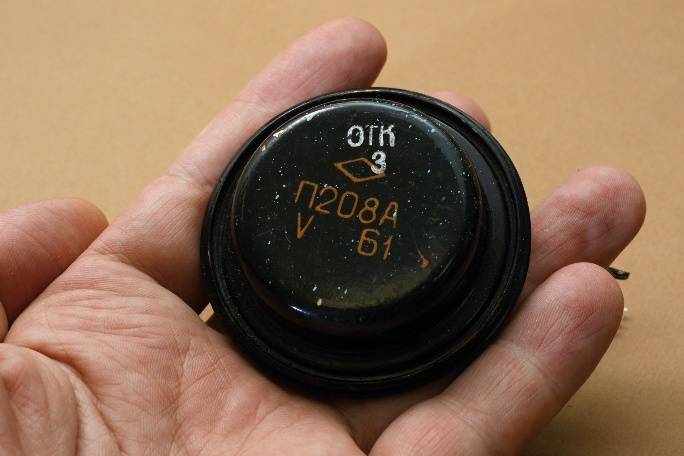
Domestic macroelectronic device - germanium transistor 25 A (photo http://www.155la3.ru)
Only after the internship of domestic specialists in Silicon Valley (1959-1960, we will talk about this period later) did the active reproduction of the American silicon mesa-diffusion technology begin.
The first transistors in space - Soviet
The first was the series P501 / P503 (1960), which was very unsuccessful, with a yield of less than 2%. Here we did not mention other series of germanium and silicon transistors, there were quite a few of them, but the above, in general, is true for them as well.
According to a widespread myth, P401 appeared already in the transmitter of the first satellite "Sputnik-1", however, carried out by space lovers from Habr research showed that it was not. The official response from the Director of the Department of Automatic Space Complexes and Systems of the State Corporation "Roscosmos" K. V. Borisov read:
However, further investigation showed that the radio equipment of the satellites was not exhausted, and germanium triodes of the P4 series were first used in the telemetry system "Tral" 2 - developed by the Special Sector of the Research Department of the Moscow Power Engineering Institute (now JSC OKB MEI) on the second satellite on November 4, 1957 of the year.
Thus, the first transistors in space turned out to be Soviet.
Let's do a little research and we - when did transistors begin to be used in computer technology in the USSR?
In 1957-1958, the Department of Automation and Telemechanics of LETI was the first in the USSR to begin research on the use of germanium transistors of the P series. It is not known exactly what kind of transistors these were. V. A. Torgashev, who worked just with them (in the future, the father of dynamic computer architectures, we will talk about him later, and in those years he was a student) recalls:
However, the designer of the ferrite memory for the "Ural" G.S. Smirnov objected:
In general, memory (and also in old age, a fanatical hobby for Stalin) played a cruel joke with Torgashev, and he is inclined to idealize his youth a little. In any case, in 1957, there was no question of any P16 cars for electrical engineering students. Their earliest known prototypes date back to 1958, and electronics engineers began to experiment with them, as the Ural designer wrote, not earlier than 1959. Of the domestic transistors, it was the P16 that were, perhaps, the first designed for pulse modes, and therefore they found wide application in early computers.
The researcher of Soviet electronics A.I. Pogorilyi writes about them:
In the 1960s, the yield of good transistors of this type was 42,5%, which was quite a high figure. It is interesting that P16 transistors were massively used in military vehicles almost until the 70s. At the same time, as always in the USSR, we were practically one-on-one with the Americans (and ahead of almost all other countries) in theoretical developments, but we were hopelessly bogged down in the serial implementation of bright ideas.
Work on the creation of the world's first computer with a transistor ALU began in 1952 at the alma mater of the entire British school of computing - the University of Manchester, with the support of Metropolitan-Vickers. Lebedev's British counterpart, the famous Tom Kilburn and his team, Richard Lawrence Grimsdale and DC Webb, using transistors (92 pieces) and 550 diodes, were able to launch the Manchester Transistor in a year. Computer. The reliability issues of the damn spotlights resulted in an average runtime of around 1,5 hours. As a result, Metropolitan-Vickers used the second version of MTC (now on bipolar transistors) as a prototype for their Metrovick 950. Six computers were built, the first of which was completed in 1956, they were successfully used in various departments of the company and lasted for about five years.
The world's second transistorized computer, the famous Bell Labs TRADIC Phase One Сomputer (later followed by Flyable TRADIC, Leprechaun and XMH-3 TRADIC) was built by Jean Howard Felker from 1951 to January 1954 in the same laboratory that gave the world transistor, as a proof-of-concept, which proved the viability of the idea. The Phase One was built with 684 Type A transistors and 10358 germanium point diodes. The Flyable TRADIC was small enough and light enough to be mounted on the B-52 Stratofortress strategic bombers, making it the first flying electronic computer. At the same time (little-remembered fact) TRADIC was not a general-purpose computer, but rather a mono-task computer, and transistors were used as amplifiers between diode-resistive logic circuits or delay lines, which served as random access memory for only 13 words.
The third (and the first fully transistorized from and to, the previous ones still used lamps in the clock generator) was the British Harwell CADET, built by the Atomic Energy Research Institute in Harwell on 324 point transistors of the British company Standard Telephones and Cables. It was completed in 1956 and worked for about 4 more years, sometimes 80 hours continuously. At Harwell CADET, the era of prototypes, produced one a year, is over. Since 1956, transistor computers have sprung up like mushrooms all over the world.
In the same year, the Japanese Electrotechnical Laboratory ETL Mark III (started in 1954, the Japanese distinguished themselves by rare sagacity) and the MIT Lincoln Laboratory TX-0 (a descendant of the famous Whirlwind and direct ancestor of the legendary DEC PDP series) were released. 1957 explodes with a whole series of the world's first military transistor computers: the Burroughs SM-65 Atlas ICBM Guidance Computer MOD1 ICBM computer, the Ramo-Wooldridge (future famous TRW) RW-30 on-board computer, UNIVAC TRANSTEC for the US Navy and his brother UNIVAC ATHENA Missile Guidance Computer for the US Air Force.
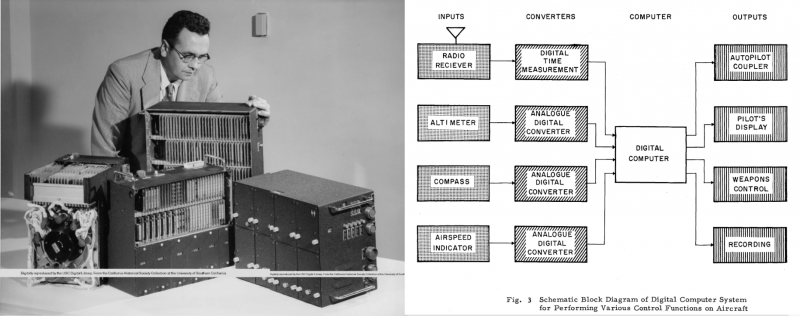
The world's first on-board computer Ramo-Wooldridge RW-30 and a scheme for using an on-board computer for an aircraft (photo - University of Southern California Digital Library and The Ramo-Wooldridge Corporation, EM Grabbe - Some Recent Developments in Digital Control systems, Feb 1957
In the next couple of years, numerous computers continued to appear: the Canadian DRTE Computer (developed by the Defense Telecommunications Research Institution, it also dealt with Canadian radars), the Dutch Electrologica X1 (developed by the Mathematical Center in Amsterdam and released by Electrologica for sale in Europe, about 30 machines in total), Austrian Binär dezimaler Volltransistor-Rechenautomat (also known as Mailüfterl), built at the Vienna University of Technology by Heinz Zemanek in collaboration with Zuse KG in 1954-1958. It served as a prototype for the transistor Zuse Z23, the same one that the Czechs bought to get tape for EPOS. Zemanek showed miracles of resourcefulness by building a car in post-war Austria, where even 10 years later there was a shortage of high-tech production, he obtained transistors, asking for a donation from the Dutch Philips.
Naturally, the production of much larger series was launched - IBM 608 Transistor Calculator (1957, USA), the first transistor serial mainframe Philco Transac S-2000 (1958, USA, on Philco's own transistors), RCA 501 (1958, USA), NCR 304 (1958, USA). Finally, in 1959, the famous IBM 1401 was released - the ancestor of the Series 1400, of which more than ten thousand were produced in 4 years.
Think about this figure - more than ten thousand, not counting the computers of all other American companies. This is more than the USSR produced ten years later and more than all Soviet cars produced from 1950 to 1970. The IBM 1401 just blew up the American market - unlike the first tube mainframes, which cost tens of millions of dollars and were installed only in the largest banks and corporations, the 1400 series was affordable even for medium (and later small) businesses. It was the conceptual ancestor of the PC - a machine that almost every office in America could afford. It was the 1400 series that gave a monstrous acceleration to American business; in terms of importance for the country, this line is on a par with ballistic missiles. After the proliferation of the 1400s, America's GDP literally doubled.

Advertising "Datamobil" IBM on the streets of Copenhagen and IBM 1401 in all its glory (photo www.ibm.com)
In general, as we can see, by 1960 the United States had made a colossal leap forward, not due to ingenious inventions, but due to ingenious management and the successful implementation of what they invented. There were still 20 years left before the generalization of Japan's computerization, Britain, as we said, missed its computers, limiting itself to prototypes and very small (about dozens of machines) series. The same thing happened everywhere in the world, here the USSR was no exception. Our technical developments were quite at the level of the leading Western countries, but in the introduction of these developments into the present mass (tens of thousands of machines) production - alas, we, in general, were also at the level of Europe, Britain and Japan.
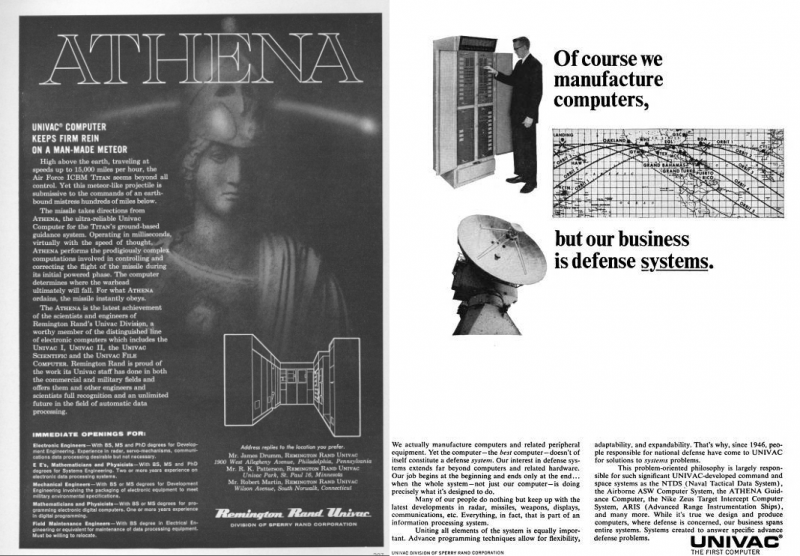
The Soviet approach to development is to make a secret so that even the neighboring research institute does not recognize, to remove the neck in 2000. The American approach is advertisement military computer Univac ATHENA and advertising of Sperry UNIVAC itself "Of course, we make computers, but our business is defense systems!" (Air Force Magazine, Volume 47).
"Setun"
Of the interesting things, we note that in the same years several unique machines appeared in the world, using much less commonplace elements instead of transistors and lamps. Two of them were assembled on amplistats (they are also transducers or magnetic amplifiers, based on the presence of a hysteresis loop in ferromagnets and designed to convert electrical signals). The first such machine was the Soviet "Setun", built by N.P. Brusentsov from Moscow State University, it was also the only serial ternary computer in stories ("Setun", however, deserves a separate discussion).
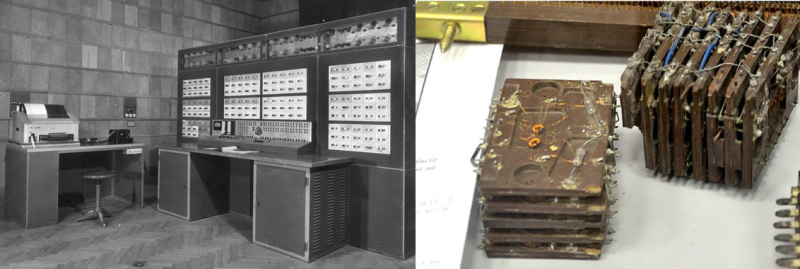
One of the few photos of the very first "Setun" in Moscow State University (much more often you can find a photo of its second version - "Setun-70") and partially ruined ternary logic cells from it (photo - Moscow State University and BM Malashevich)
The second machine was produced in France by Société d'électronique et d'automatisme (the Society of Electronics and Automation, founded in 1948, played a key role in the development of the French computer industry, training several generations of engineers and building 170 computers between 1955 and 1967). The SEA CAB-500 was based on the Symmag 200 magnetic core circuits developed by SEA.They were assembled on toroids powered by a 200 kHz circuit. Unlike the Setun, the CAB-500 was binary.
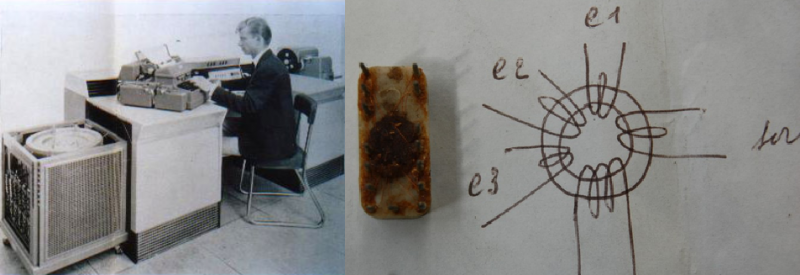
A photo, alas, of poor quality, of a rare SEA CAB-500 car and a Symmag 200 diagram next to the element itself (photo from the archive of French fans of old computers, https://www.histoireinform.com)
Finally, the Japanese went their own way and developed in 1958 at the University of Tokyo the PC-1 Parametron Computer - a machine on parametrons. It is a logic element invented by the Japanese engineer Eiichi Goto in 1954 - a resonant circuit with a nonlinear reactive element that maintains oscillations at half the fundamental frequency. These oscillations can represent a binary symbol by choosing between two stationary phases. A whole family of prototypes was built on parametrons, in addition to PC-1, MUSASINO-1, SENAC-1 and others are known, in the early 1960s Japan finally received high-quality transistors and abandoned the slower and more complex parametrons. However, an improved version of the MUSASINO-1B, built by the Nippon Telegram and Telephone Public Corporation (NTT), was later sold by Fuji Telecommunications Manufacturing (now Fujitsu) under the name FACOM 201 and served as the basis for a number of early Fujtisu parametron computers.
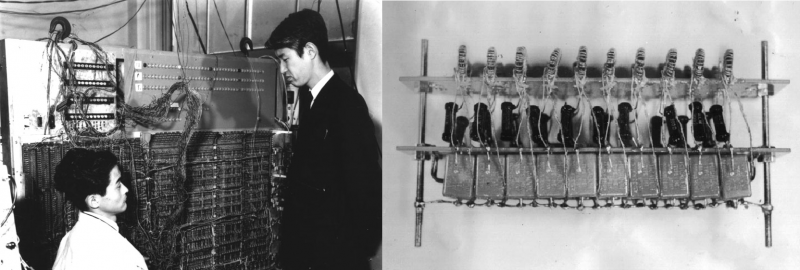
The creator of the first Japanese computer on parametrons Hidetosi Takahasi (right) and inventor Eiichi Goto assemble PC-1, an ALU cell on parametrons from PC-1 (photo from the Museum of the Heritage of Japanese Computing, http://museum.ipsj.or.jp )
"Radon"
In the USSR, in terms of transistor machines, two main directions arose: alteration on a new element base of existing computers and, in parallel, the secret development of new architectures for the military. The second direction we had was so fiercely classified that information about the early transistor machines of the 1950s had to be collected literally bit by bit. In total, there were three projects of non-specialized computers, brought to the stage of a working computer: M-4 Kartseva, "Radon" and the most mystical one - M-54 "Volga".
With Kartsev's project, everything is more or less clear. Best of all, he himself will say about this (from the memoirs of 1983, shortly before his death):
In November 1962, a decree was issued on the launch of the M-4 into mass production. But we perfectly understood that the car was not suitable for mass production. It was the first experimental machine made with transistors. It was difficult to adjust, it would be difficult to repeat it in production, and, in addition, for the period 1957-1962, semiconductor technology made such a leap that we could make a machine that would be an order of magnitude better than the M-4, and an order of magnitude more powerful than the computers that were produced by that time in the Soviet Union.
Throughout the winter of 1962-1963 there were heated debates.
The management of the institute (we were then at the Institute of Electronic Control Machines) categorically objected to the development of a new machine, arguing that in such a short time we would never be able to do this, that this was an adventure, that this would never happen ...
Note that the words "this is a gamble, you can not" Kartsev said all his life, and all his life he could and did, and so it happened then. M-4 was completed, and in 1960 was used for its intended purpose for experiments in the field of missile defense. Two sets were manufactured that worked together with the radar stations of the experimental complex until 1966. The RAM of the M-4 prototype also had to use up to 100 electron tubes. However, we have already mentioned that this was the norm in those years, the first transistors were not suitable for such a task at all, for example, in the MIT ferrite memory (1957), 0 transistors and 625 lamps were used for the experimental TX-425.
With "Radon" it is already more difficult, this machine has been developed since 1956, the father of the entire "P" series, NII-35, was responsible for the transistors, as usual (in fact, for "Radon" they began to develop the P16 and P601 - greatly improved in comparison with P1 / P3), for the order - SKB-245, the development was in NIEM, and produced at the Moscow plant SAM (this is such a difficult genealogy). Chief Designer - S. A. Krutovskikh.
However, the situation with "Radon" went worse, and the car was finished only by 1964, so it did not fit among the first, moreover, this year prototypes of microcircuits have already appeared, and computers in the USA began to be assembled on SLT-modules ... Perhaps the reason for the delay was that this epic machine occupied 16 cabinets and a 150 sq. m, and the processor contained as many as two index registers, which was incredibly cool by the standards of Soviet machines of those years (remembering BESM-6 with a primitive register-accumulator scheme, one can be glad for the Radon programmers). A total of 10 copies were made, working (and hopelessly obsolete) until the mid-1970s.
Volga
And finally, without exaggeration, the most mysterious vehicle of the USSR is the Volga.
It is so secret that there is no information about it even in the famous Virtual Computer Museum (https://www.computer-museum.ru/), and even Boris Malashevich bypassed it in all his articles. One could decide that it did not exist at all, nevertheless, the archival research of a very authoritative journal on electronics and computer technology (https://1500py470.livejournal.com/) provide the following information.
SKB-245 was, in a sense, the most progressive in the USSR (yes, we agree, after Strela it’s hard to believe, but it turns out that it was!), They wanted to develop a transistor computer literally simultaneously with the Americans (!) Even in the very the early 1950s, when we did not even have a proper production of point transistors. As a result, they had to do everything from scratch.
The CAM plant organized the production of semiconductors - diodes and transistors, especially for their military projects. The transistors were made almost piecemeal, they had non-standard everything - from design to marking, and even the most fanatical collectors of Soviet semiconductors still, for the most part, have no idea why they were needed. In particular, on the most authoritative site - collections of Soviet semiconductors (http://www.155la3.ru/) it says about them:
As it turned out, they needed transistors for the Volga.
The machine was developed from 1954 to 1957, had (for the first time in the USSR and simultaneously with MIT!) Ferrite memory (and this was at the time when Lebedev fought for potentioscopes with Strela with the same SKB!), Also had microprogram control for the first time ( for the first time in the USSR and simultaneously with the British!). CAM transistors in later versions were replaced by P6. In general, the "Volga" was more perfect than TRADIC and quite at the level of the world's leading models, surpassing the typical Soviet technology by a generation. The development was supervised by AA Timofeev and Yu. F. Shcherbakov.
What happened to her?

M-4 Kartseva (left) and the most secret computer in the world - M-54 Volga (right). There is no photo left of "Radon" at all (photos http://ukrainiancomputing.org/ and https://1500py470.livejournal.com/
And here the legendary Soviet management got involved.
The development was so classified that even now a maximum of a couple of people heard about it (and it is not mentioned at all anywhere among Soviet computers). The prototype was transferred in 1958 to the Moscow Power Engineering Institute, where it got lost. The M-180 created on its basis went to the Ryazan Radio Engineering Institute, where a similar fate befell her. And none of the outstanding technological breakthroughs of this machine was used in serial Soviet computers of that time, and in parallel with the development of this miracle of technology, SKB-245 continued to produce the monstrous "Arrow" on delay lines and lamps.
Not a single developer of civilian vehicles knew about the Volga, not even Rameev from the same SKB, which received transistors for the Ural only in the early 1960s. At the same time, the idea of ferrite memory began to penetrate the broad masses, with a delay of 5-6 years.
What finally kills in this story is that in April-May 1959, Academician Lebedev traveled to the United States to visit IBM and MIT, and studied the architecture of American computers, while talking about Soviet advanced achievements. So, having seen the TX-0, he boasted that the Soviet Union had built a similar machine a little earlier and mentioned the very Volga! As a result, an article with its description appeared in Communications of the ACM (V. 2 / N.11 / November, 1959), despite the fact that in the USSR a maximum of several dozen people knew about this machine over the next 50 years.
We will talk later about how this trip influenced and whether this trip influenced the development of Lebedev himself, in particular, BESM-6.
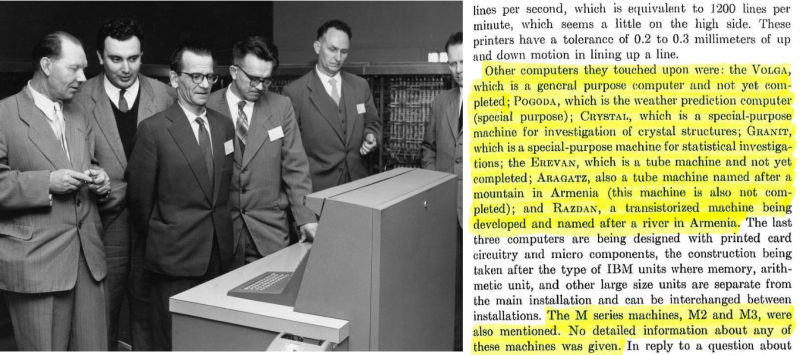
Lebedev (very recognizable in any photograph) in the United States and an excerpt from the same article (photo https://1500py470.livejournal.com/)
The first ever computer animation
In addition to these three computers, by the 1960s, the release of a number of specialized military vehicles with little meaningful indices 5E61 (Bazilevsky Yu. Ya., SKB-245, 1962) 5E89 (Ya.A. Khetagurov, MNII 1, 1962) and 5E92b (S. A. Lebedev and V. S. Burtsev, ITMiVT, 1964).
Civilian developers immediately pulled up, in 1960 the group of E. L. Brusilovsky in Yerevan completed the development of the semiconductor computer "Hrazdan-2" (a converted lamp "Hrazdan"), its serial production began in 1961. In the same year, Lebedev builds the BESM-3M (converted to M-20 transistors, a prototype), in 1965 the production of the BESM-4 based on it begins (only 30 cars, but the first animation in the world was calculated frame by frame - a tiny cartoon " Kitty "!). In 1966, the crown of Lebedev's design school appears - BESM-6, which over the years has overgrown with myths, like an old ship with shells, but so important that we will devote a separate part to its study.
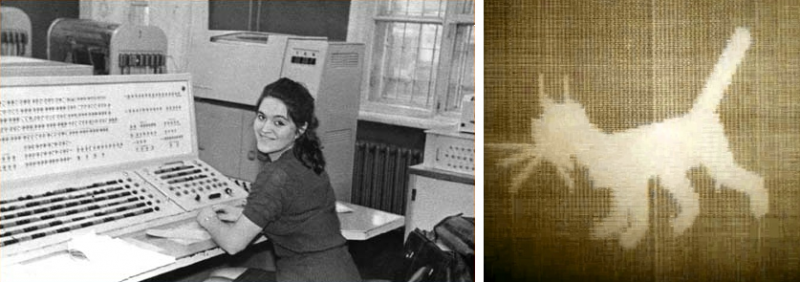
Everyone loves cats! BESM-4 and the first computer animation in history (photo https://ru.wikipedia.org/)
The mid-1960s is considered the golden age of Soviet computers - at this time computers were released with many unique architectural features that allowed them to rightfully enter the annals of world computing. In addition, for the first time, the production of machines, although it remained negligible, reached a level when at least a few engineers and scientists outside the Moscow and Leningrad defense research institutes could see these machines.
Minsk Computer Plant named after V.I. Sergo Ordzhonikidze in 1963 produced the transistor Minsk-2, and then its modifications from Minsk-22 to Minsk-32. At the Institute of Cybernetics of the Academy of Sciences of the Ukrainian SSR, under the leadership of V.M. Glushkov, a number of small machines are being developed: "Promin" (1962), MIR (1965) and MIR-2 (1969) - subsequently used in universities and research institutes. In 1965, a transistorized version of the Uralov was put into production in Penza (chief designer B. I. Rameev, Ural-11, Ural-12 were serials, and Ural-16, the most powerful, remained the only one) ... In general, from 1964 to 1969, transistor computers began to be produced in almost every region - except for Minsk, in Belarus they produced Vesna and Sneg machines, in Ukraine - specialized control computers "Dnepr", in Yerevan - Nairi.
All this splendor had only a few problems, but their severity grew every year.
Firstly, according to the old Soviet tradition, not only machines from different design bureaus were incompatible with each other, but even machines of the same line! For example, "Minsk" operated with 31-bit bytes (yes, the 8-bit byte appeared in S / 360 in 1964 and did not become a standard at once), "Minsk-2" - 37 bits, and "Minsk-23", in general , had a unique and incompatible variable-length instruction system based on bit addressing and symbolic logic - and all this over the course of 2-3 years of release.
Soviet designers were like playing children who got hung up on the idea of doing something very interesting and exciting, completely ignoring all the problems of the real world - the complexity of mass production and engineering support of a bunch of different models, training specialists who understand dozens of completely incompatible machines at the same time, rewriting in general, all software (and often not even in assembler, but directly in binary codes) for each new modification, the inability to exchange programs and even the results of their work in machine-dependent data formats between different research institutes and factories, etc.
Secondly, all the machines were produced in insignificant editions, although they were an order of magnitude larger than the lamp ones - in just the 1960s, no more than 1500 transistor computers of all modifications were produced in the USSR. It was not enough. It was monstrous, catastrophically negligible for a country whose industrial and scientific potential seriously wanted to compete with the United States, where only one IBM released the already mentioned 10000 compatible computers in 4 years.
As a result, later, in the era of Cray-1, the State Planning Commission counted on tabulators of the 20s, engineers built bridges with the help of hydrointegrators, and tens of thousands of office workers twisted the iron handle of the Felix. The value of the few transistor machines was such that they were produced until the 1980s (think about this date!), And the last BESM-6 was dismantled in 1995. But what about transistors, back in 1964 in Penza, the oldest tube computer continued to be produced " Ural-4 ", which served for economic calculations, and in the same year, the production of the tube M-20 was finally curtailed!
The third problem is that the more high-tech production is, the more difficult it was for the Soviet Union to master it. Transistor machines were already 5-7 years late, in 1964 the first third-generation machines were already mass-produced in the world - on hybrid assemblies and ICs, but, as you remember, by the year of the invention of ICs we could not catch up with the Americans even in the production of high-quality transistors ... We had attempts to develop a technology for photolithography, but ran into insurmountable obstacles in the form of party bureaucracy, knocking out a plan, academic intrigue and other traditional things that we have already seen. Moreover, the production of ICs was an order of magnitude more complicated than the transistor one; for its appearance in the early 1960s, it was necessary to work on the topic at least from the mid-1950s, as in the United States, at the same time training engineers, developing fundamental science and technology, and all this - in complex.
In addition, Soviet scientists had to knock out and push their inventions through officials who did not understand anything decisively. The production of microelectronics required financial investments comparable to nuclear and space research, but the visible result of such research was the opposite for an uneducated person - rockets and bombs became larger, inspiring awe of the power of the Union, and computers turned into small nondescript boxes. In order to convey the importance of their research, in the USSR it was necessary to be not a technician, but a genius of specific advertising for officials, as well as a promoter along the party line. Unfortunately, among the developers of integrated circuits, there was no person with PR-talents Kurchatov and Korolev. The favorite of the Communist Party and the Academy of Sciences of the USSR, Lebedev was then already too old for some newfangled microcircuits and until the end of his days received money for ancient transistor machines.
This does not mean that we did not try to somehow rectify the situation - already in the early 1960s, the USSR, realizing that it was beginning to enter the deadly peak of a total lag in microelectronics, was feverishly trying to change the situation. Four methods are used - going abroad to study best practices, using American deserted engineers, buying technological production lines, and outright theft of integrated circuit designs. However, as later, in other areas, this scheme, being fundamentally unsuccessful in some moments and poorly executed in others, did not help much.
Since 1959, GKET (State Committee on Electronic Technology) begins to send people to the United States and Europe in large quantities to study the microelectronic industry. This idea failed for several reasons - firstly, the most interesting things happened in the defense industry behind closed doors, and secondly, who from the Soviet masses received the opportunity to study in the United States as a reward? The most promising students, graduate students and young designers?
Here is an incomplete list of those sent for the first time - A.F. Trutko (director of the Research Institute "Pulsar"), V.P. Tsvetov (head of the SKTB Svetlana), B.V. Malin (head of the integrated circuit development department of the research institute "Pulsar") , II Kruglov (chief engineer of the scientific research institute "Sapphire"), party bosses and directors left to adopt the advanced experience.
Nevertheless, as in all other industries in the USSR, a genius was found in the production of microcircuits, who blazed a completely original path. We are talking about a remarkable microcircuit designer Yuri Valentinovich Osokin, who completely independently of Kilby came up with the idea of miniaturizing electronic components and even partially brought his ideas to life. We will talk about him next time.
Information